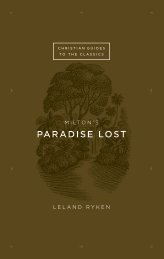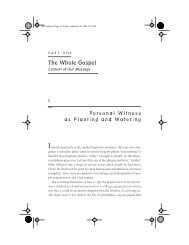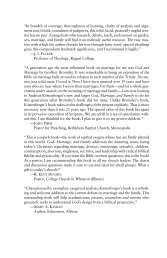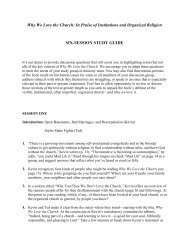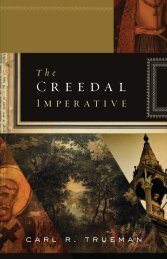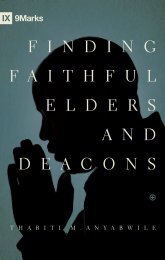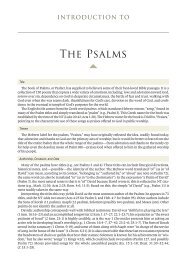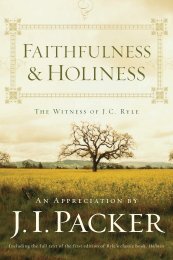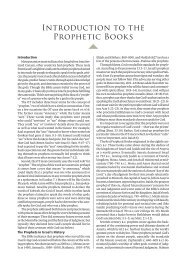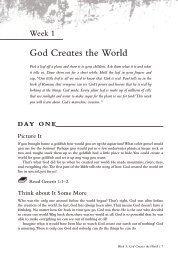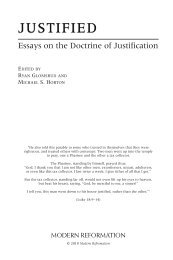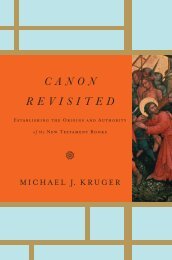PDF - Monergism Books
PDF - Monergism Books
PDF - Monergism Books
You also want an ePaper? Increase the reach of your titles
YUMPU automatically turns print PDFs into web optimized ePapers that Google loves.
“‘R. C. Sproul,’ someone said to me in the 1970s, ‘is the finest communicator in the Reformed world.’<br />
Now, three decades later, his skills honed by long practice, his understanding deepened by years<br />
of prayer, meditation, and testing (as Martin Luther counseled), R. C. shares the fruit of what has<br />
become perhaps his greatest love: feeding and nourishing his own congregation at St. Andrew’s from<br />
the Word of God and building them up in faith and fellowship and in Christian living and serving.<br />
The St. Andrew’s Expositional Commentary will be welcomed throughout the world. It promises to<br />
have all R. C.’s hallmarks: clarity and liveliness, humor and pathos, always expressed in application<br />
to the mind, will, and affections. R. C.’s ability to focus on ‘the big picture,’ his genius of never saying<br />
too much, leaving his hearers satisfied yet wanting more, never making the Word dull, are all present<br />
in these expositions. They are his gift to the wider church. May they nourish God’s people well and<br />
serve as models of the kind of ministry for which we continue to hunger.”<br />
—Sinclair B. Ferguson, Senior Minister,<br />
First Presbyterian Church, Columbia, South Carolina<br />
“R. C. Sproul, well known as a master theologian and extraordinary communicator, now shows that<br />
he is a powerful, insightful, helpful expository preacher. This collection of sermons is of great value<br />
for churches and Christians everywhere.”<br />
—W. Robert Godfrey, President, Westminster Seminary California<br />
“I tell my students again and again, ‘You need to buy good commentaries and do so with some<br />
discernment.’ Among them there must be preacher’s commentaries, for not all commentaries are<br />
the same. Some may tell you what the text means but provide little help in answering the question,<br />
‘How do I preach this text?’ R. C. Sproul is a legend in our time. His preaching has held us in awe<br />
for half a century, and these pages represent the fruit of his latest exposition, coming as they do at<br />
the very peak of his abilities and insights. I am ecstatic at the prospect of reading the St. Andrew’s<br />
Expositional Commentary series. It represents Reformed theology on fire, delivered from a pastor’s<br />
heart in a vibrant congregation of our time. Essential reading.”<br />
—Derek W. H. Thomas,<br />
John E. Richards Professor of Systematic and Practical Theology,<br />
Reformed Theological Seminary;<br />
Minister of Teaching, First Presbyterian Church, Jackson, Mississippi<br />
“R.C. Sproul is the premier theologian of our day, an extraordinary instrument in the hand of the<br />
Lord. Possessed with penetrating insight into the text of Scripture, Dr. Sproul is a gifted expositor<br />
and world-class teacher, endowed with a strategic grasp and command of the inspired Word. Since<br />
stepping into the pulpit of St. Andrew’s and committing himself to the weekly discipline of biblical<br />
exposition, this noted preacher has demonstrated a rare ability to explicate and apply God’s Word. I<br />
wholeheartedly recommend the St. Andrew’s Expositional Commentary to all who long to know the<br />
truth better and experience it more deeply in a life-changing fashion. Here is an indispensable tool<br />
for digging deeper into God’s Word. This is a must-read for every Christian.”<br />
—Steven J. Lawson, Senior Pastor, Christ Fellowship Baptist Church, Mobile, Alabama<br />
“How exciting! Thousands of us have long been indebted to R. C. Sproul the teacher, and now,<br />
through the St. Andrew’s Expositional Commentary, we are indebted to Sproul the preacher, whose<br />
sermons are thoroughly biblical, soundly doctrinal, warmly practical, and wonderfully readable.<br />
Sproul masterfully presents us with the ‘big picture’ of each pericope in a dignified yet conversational<br />
style that accentuates the glory of God and meets the real needs of sinful people like us. This<br />
series of volumes is an absolute must for every Reformed preacher and church member who yearns<br />
to grow in the grace and knowledge of Christ Jesus. I predict that Sproul’s pulpit ministry in written<br />
form will do for Christians in the twenty-first century what Martyn Lloyd-Jones’s sermonic commentaries<br />
did for us last century. Tolle lege, and buy these volumes for your friends.”<br />
—Joel R. Beeke, President, Puritan Reformed Theological Seminary
Matthew<br />
Copyright © 2013 by R. C. Sproul<br />
Published by Crossway<br />
1300 Crescent Street<br />
Wheaton, Illinois 60187<br />
All rights reserved. No part of this publication may be reproduced, stored in a retrieval system, or<br />
transmitted in any form by any means, electronic, mechanical, photocopy, recording, or otherwise,<br />
without the prior permission of the publisher, except as provided for by USA copyright law.<br />
Cover design: Geoff Stevens, Ligonier<br />
First printing 2013<br />
Printed in the United States of America<br />
Scripture references are from The New King James Version. Copyright © 1982, Thomas Nelson, Inc.<br />
Used by permission.<br />
All emphasis in Scripture quotations have been added by the author.<br />
Hardcover ISBN: 978-1-4335-3175-0<br />
<strong>PDF</strong> ISBN: 978-1-4335-3176-7<br />
Mobipocket ISBN: 978-1-4335-3177-4<br />
ePub ISBN: 978-1-4335-3178-1<br />
Library of Congress Cataloging-in-Publication Data<br />
Sproul, R. C. (Robert Charles), 1939-<br />
Matthew / R.C. Sproul.<br />
pages cm. — (St. Andrew’s expositional commentary)<br />
Includes bibliographical references and index.<br />
ISBN 978-1-4335-3175-0 (hc)<br />
1. Bible. N.T. Matthew—Commentaries. I. Title.<br />
BS2575.53.S67 2013<br />
226.2'077—dc232012040404<br />
Crossway is a publishing ministry of Good News Publishers.<br />
SH 22 21 20 19 18 17 16 15 14 13<br />
15 14 13 12 11 10 9 8 7 6 5 4 3 2 1
CONTENTS<br />
Series Preface 13<br />
1 A Jewish Look at Jesus (1:1–17) 15<br />
2 The Birth of Jesus (1:18–25) 21<br />
3 Visit of the Magi (2:1–12) 27<br />
4 The Slaughter of the Innocents (2:13–23) 33<br />
5 John the Baptist (3:1–12) 39<br />
6 The Baptism of Jesus (3:13–17) 45<br />
7 The Temptation of Jesus, Part 1 (4:1–11) 49<br />
8 The Temptation of Jesus, Part 2 (4:1–11) 55<br />
9 Jesus Goes to Galilee (4:12–17) 61<br />
10 Jesus’ Disciples and Ministries (4:18–25) 67<br />
11 The Beatitudes, Part 1 (5:1–4) 73<br />
12 The Beatitudes, Part 2 (5:4–9) 79<br />
13 The Beatitudes, Part 3 (5:7–9) 85<br />
14 The Beatitudes, Part 4 (5:10–12) 91<br />
15 Sermon on the Mount (5:13–16) 95<br />
16 Christ and the Law (5:17–20) 101<br />
17 Jesus’ View of Murder (5:21–26) 107<br />
18 Jesus’ View of Adultery (5:27–30) 111<br />
19 Oaths and Vows (5:33–37) 117<br />
20 Loving Our Enemies (5:38–48) 123<br />
21 Private Piety (6:1–4) 129<br />
22 Sincere Prayer (6:5–9) 135<br />
23 Our Father’s House (6:9) 141<br />
24 Hallowed Be Your Name (6:9–10) 145<br />
25 Thy Kingdom Come (6:9b–11) 149<br />
26 Daily Bread (6:11) 155
27 Forgive Us Our Debts (6:12) 159<br />
28 Lead Us Not into Temptation (6:13a) 167<br />
29 Thine Is the Kingdom (6:13b) 173<br />
30 Treasure in Heaven (6:19–24) 177<br />
31 Do Not Be Anxious (6:25–34) 181<br />
32 Judge Not (7:1–6) 187<br />
33 Ask and Receive (7:7–12) 193<br />
34 The Narrow Way (7:13–20) 199<br />
35 “Lord, Lord” (7:21–23) 205<br />
36 A Firm Foundation (7:24–29) 213<br />
37 The Cleansing of the Leper (8:1–4) 219<br />
38 The Centurion’s Servant and Peter’s Mother-in-Law (8:5–15) 225<br />
39 The Healer Who Was to Come (8:16–17) 233<br />
40 The Cost of Discipleship (8:18–22) 239<br />
41 The Calming of the Sea (8:23–27) 247<br />
42 Before the Time (8:28–34) 253<br />
43 Jesus Forgives Sin (9:1–8) 261<br />
44 The Call of Matthew (9:9–13) 269<br />
45 The Presence of the Bridegroom (9:14–17) 275<br />
46 Two Daughters Healed (9:18–26) 281<br />
47 The Compassion of Jesus (9:27–34) 287<br />
48 The Fields Ready to Harvest (9:35–38) 293<br />
49 The Commissioning of the Apostles (10:1–4) 299<br />
50 The Sending of the Twelve (10:5–15) 305<br />
51 Persecutions (10:16–23) 311<br />
52 The Fear of God (10:24–33) 319<br />
53 Jesus and Division (10:34–42) 327<br />
54 John the Baptist’s Inquiry (11:1–11) 333<br />
55 The Greatness of John the Baptist (11:12–19) 341<br />
56 Woes on the Cities (11:20–24) 347<br />
57 The Yoke of Christ (11:25–30) 355
58 The Lord of the Sabbath (12:1–8) 361<br />
59 The Servant of the Lord (12:9–21) 367<br />
60 War between the Kingdoms (12:22–30) 375<br />
61 The Unpardonable Sin (12:31–32) 383<br />
62 The Tree and Its Fruits (12:33–37) 389<br />
63 Asking for a Sign (12:38–42) 395<br />
64 Who Are My Brothers? (12:43–50) 401<br />
65 The Parable of the Sower, Part 1 (13:1–17) 407<br />
66 The Parable of the Sower, Part 2 (13:1–9, 18–23) 413<br />
67 The Parable of the Sower, Part 3 (13:8–9, 18–23) 421<br />
68 The Parable of the Tares (13:24–30, 36–43) 427<br />
69 The Mustard Seed and the Leaven (13:31–35) 435<br />
70 Three Parables (13:44–58) 441<br />
71 The Death of John the Baptist (14:1–12) 449<br />
72 The Feeding of the Five Thousand (14:13–21) 455<br />
73 Jesus Walks on Water (14:22–36) 461<br />
74 Inner Defilement (15:1–20) 469<br />
75 A Gentile Woman (15:21–39) 477<br />
76 The Leaven of the Pharisees (16:1–12) 485<br />
77 The Great Confession (16:13–20) 491<br />
78 The Shadow of the Cross (16:21–28) 497<br />
79 The Transfiguration (17:1–9) 503<br />
80 The Coming of Elijah (17:10–13) 509<br />
81 A Faithless Generation (17:14–21) 515<br />
82 Paying the Tax (17:22–27) 521<br />
83 The Greatest in the Kingdom of Heaven (18:1–5) 527<br />
84 Dealing with Temptation (18:6–9) 533<br />
85 The Parable of the Lost Sheep (18:10–14) 539<br />
86 Discipline (18:15–20) 545<br />
87 The Unforgiving Servant (18:21–35) 551<br />
88 Marriage and Divorce (19:1–12) 557
89 Jesus and the Children (19:13–15) 563<br />
90 The Rich Young Ruler (19:16–22) 571<br />
91 All Things Are Possible (19:23–30) 577<br />
92 The Parable of the Workers (20:1–16) 583<br />
93 Service (20:17–34) 589<br />
94 The Triumphal Entry (21:1–11) 595<br />
95 The Cleansing of the Temple (21:12–17) 601<br />
96 The Cursing of the Fig Tree (21:18–22) 607<br />
97 The Authority of Jesus (21:23–32) 613<br />
98 The Parable of the Vineyard (21:33–46) 619<br />
99 The Parable of the Marriage Feast (22:1–14) 625<br />
100 Render to Caesar (22:15–22) 631<br />
101 The Resurrection (22:23–33) 637<br />
102 The First Commandment (22:34–40) 643<br />
103 David’s Son and Lord (22:41–46) 649<br />
104 Woes to the Pharisees, Part 1 (23:1–12) 655<br />
105 Woes to the Pharisees, Part 2 (23:13–22) 661<br />
106 Woes to the Pharisees, Part 3 (23:23–28) 667<br />
107 Woes to the Pharisees, Part 4 (23:29–39) 673<br />
108 The Destruction of the Temple (24:1–3, 32–35) 679<br />
109 The Signs of the End (24:3–14) 685<br />
110 The Great Tribulation (24:15–28) 691<br />
111 The Coming of the Son of Man (24:29–31) 699<br />
112 The Day and the Hour (24:36–44) 705<br />
113 The Faithful and Evil Servants (24:45–51) 711<br />
114 The Parable of the Wise and Foolish Virgins (25:1–13) 717<br />
115 The Parable of the Talents (25:14–30) 723<br />
116 The Judgment of Christ (25:31–46) 731<br />
117 The Anointing at Bethany (26:1–13) 737<br />
118 Judas’s Betrayal (26:14–25) 743<br />
119 The Lord’s Supper (26:26–35) 751
120 The Garden of Gethsemane (26:36–46) 757<br />
121 Jesus’ Arrest (26:47–56) 765<br />
122 Jesus before Caiaphas (26:57–68) 771<br />
123 Peter’s Denial (26:69–75) 777<br />
124 The Remorse of Judas (27:1–10) 783<br />
125 Jesus before Pilate (27:11–26) 789<br />
126 The Crucifixion (27:27–44) 797<br />
127 Jesus’ Death and Burial (27:45–66) 803<br />
128 The Resurrection (28:1–15) 813<br />
129 The Great Commission (28:16–20) 821<br />
Index of Names 828
SERIES PREFACE<br />
When God called me into full-time Christian ministry, He called<br />
me to the academy. I was trained and ordained to a ministry<br />
of teaching, and the majority of my adult life has been devoted<br />
to preparing young men for the Christian ministry and to trying to bridge<br />
the gap between seminary and Sunday school through various means<br />
under the aegis of Ligonier Ministries.<br />
Then, in 1997, God did something I never anticipated: He placed me<br />
in the position of preaching weekly as a leader of a congregation of His<br />
people—St. Andrew’s in Sanford, Florida. Over the past twelve years, as<br />
I have opened the Word of God on a weekly basis for these dear saints,<br />
I have come to love the task of the local minister. Though my role as a<br />
teacher continues, I am eternally grateful to God that He saw fit to place<br />
me in this new ministry, the ministry of a preacher.<br />
Very early in my tenure with St. Andrew’s, I determined that I should<br />
adopt the ancient Christian practice of lectio continua, “continuous expositions,”<br />
in my preaching. This method of preaching verse-by-verse through<br />
books of the Bible (rather than choosing a new topic each week) has been<br />
attested throughout church history as the one approach that ensures believers<br />
hear the full counsel of God. Therefore, I began preaching lengthy<br />
series of messages at St. Andrew’s, eventually working my way through<br />
several biblical books in a practice that continues to the present day.<br />
Previously, I had taught through books of the Bible in various settings,<br />
including Sunday school classes, Bible studies, and audio and video teaching<br />
series for Ligonier Ministries. But now I found myself appealing not so<br />
much to the minds of my hearers but to both their minds and their hearts.<br />
13
14<br />
Series Preface<br />
I knew that I was responsible as a preacher to clearly explain God’s Word<br />
and to show how we ought to live in light of it. I sought to fulfill both tasks<br />
as I ascended the St. Andrew’s pulpit each week.<br />
What you hold in your hand, then, is a written record of my preaching<br />
labors amidst my beloved Sanford congregation. The dear saints who sit<br />
under my preaching encouraged me to give my sermons a broader hearing.<br />
To that end, the chapters that follow were adapted from a sermon<br />
series I preached at St. Andrew’s.<br />
Please be aware that this book is part of a broader series of books containing<br />
adaptations of my St. Andrew’s sermons. The title of this series<br />
is St. Andrew’s Expositional Commentary. As you can see, this is more<br />
than a convenient title—it is a description. This book, like all the others in<br />
the series, will not give you the fullest possible insight into each and every<br />
verse in this biblical book. Though I sought to at least touch on each verse,<br />
I focused on the key themes and ideas that comprised the “big picture” of<br />
each passage I covered. Therefore, I urge you to use this book as an overview<br />
and introduction.<br />
I pray that you will be as blessed in reading this material as I was in<br />
preaching it.<br />
R. C. Sproul<br />
Lake Mary, Florida<br />
April 2009
1<br />
A JEWISH LOOK AT JESUS<br />
Matthew 1:1–17<br />
><br />
The book of the genealogy of Jesus Christ, the Son of David, the Son of<br />
Abraham: Abraham begot Isaac, Isaac begot Jacob, and Jacob begot Judah<br />
and his brothers. Judah begot Perez and Zerah by Tamar, Perez begot<br />
Hezron, and Hezron begot Ram. Ram begot Amminadab, Amminadab<br />
begot Nahshon, and Nahshon begot Salmon. Salmon begot Boaz by Rahab,<br />
Boaz begot Obed by Ruth, Obed begot Jesse, and Jesse begot David the<br />
king. David the king begot Solomon by her who had been the wife of<br />
Uriah. Solomon begot Rehoboam, Rehoboam begot Abijah, and Abijah<br />
begot Asa. Asa begot Jehoshaphat, Jehoshaphat begot Joram, and Joram<br />
begot Uzziah. Uzziah begot Jotham, Jotham begot Ahaz, and Ahaz begot<br />
Hezekiah. Hezekiah begot Manasseh, Manasseh begot Amon, and Amon<br />
begot Josiah. Josiah begot Jeconiah and his brothers about the time they<br />
were carried away to Babylon. And after they were brought to Babylon,<br />
Jeconiah begot Shealtiel, and Shealtiel begot Zerubbabel. Zerubbabel begot<br />
Abiud, Abiud begot Eliakim, and Eliakim begot Azor. Azor begot Zadok,<br />
Zadok begot Achim, and Achim begot Eliud. Eliud begot Eleazar, Eleazar<br />
begot Matthan, and Matthan begot Jacob. And Jacob begot Joseph the husband<br />
of Mary, of whom was born Jesus who is called Christ. So all the generations<br />
from Abraham to David are fourteen generations, from David until<br />
the captivity in Babylon are fourteen generations, and from the captivity in<br />
Babylon until the Christ are fourteen generations.<br />
15
16<br />
Matthew<br />
We do not know definitively who wrote the Gospel of Matthew,<br />
but the universal testimony of the early church is that it was<br />
penned by Matthew, one of the twelve disciples. Matthew<br />
was called from his labor as a tax collector, which was one of the most<br />
despised vocations any Jew could hold, yet because of his training as a<br />
tax collector, Matthew was acquainted with lists and genealogies from the<br />
public registry, so he would know the family history of the people being<br />
taxed. He was also, obviously, literate and probably spoke two or three<br />
languages. Therefore, his work as a tax collector, under the providence of<br />
God, was the Lord’s preparation for Matthew to begin his most important<br />
and celebrated task. This book has been called, even by critics of historic<br />
Christianity, the greatest book ever written.<br />
The Genealogy<br />
Matthew begins his Gospel with these words: The book of the genealogy<br />
of Jesus Christ (v. 1). Here is a Jew writing principally for Jews,<br />
and his first assertion is that he is writing about Jesus Messiah. Christ is not<br />
the name of Jesus. His name is Jesus bar Joseph or Jesus of Nazareth. The<br />
term Christ is His title, and it means “Jesus the Anointed One” or “Jesus the<br />
promised Messiah.” Matthew mentions another important title that would<br />
resonate with his Jewish audience: the Son of David (v. 1). This title for<br />
Jesus, Son of David, is used more by Matthew than by any other Gospel<br />
writer, because the Messiah was to come from the loins of the greatest king<br />
of the Old Testament; He would be of the seed and lineage of David. So<br />
from the very beginning of his Gospel Matthew calls Jesus “Christ, the<br />
Son of David.”<br />
Matthew then adds, the Son of Abraham (v. 1). One of the great difficulties<br />
of harmonization in sacred Scripture is the relationship between<br />
the genealogy presented by Matthew and that presented by Luke in his<br />
Gospel. There are many places where these two genealogies do not agree.<br />
The first point of difference is that Luke traces the genealogy of Christ<br />
back to Adam, indicating that this Christ is not simply the Savior of the<br />
Jews but that the scope of Jesus’ redemptive activity is universal. He is the<br />
new Adam, who recovers the promise that God made originally to Adam<br />
and Eve in the garden. Matthew, on the other hand, goes only as far back<br />
as Abraham because he is writing to a Jewish audience, to people who<br />
would want to know about the ancestry of Jesus as well as that of Matthew.<br />
It is important that His ancestry can be taken back to Abraham.<br />
Ancestry was important to Jewish people, as it has been to people of all
A Jewish Look at Jesus (1:1–17)17<br />
cultures throughout history. Probably the culture that is least concerned<br />
about ancestry is our own, which is why we often fail to understand the<br />
import of lists such as this.<br />
When I enrolled as a student at the Free University of Amsterdam, I had<br />
to fill out a form with personal information. One of the questions on the<br />
form asked, “What was your father’s station in life?” The university wanted<br />
to know my cultural class standing. That was also important for the Jew,<br />
which is why Matthew begins by giving us Jesus’ ancestry. Additionally,<br />
the ancestry was important to demonstrate that Matthew’s Gospel did not<br />
pertain to a mythical character or hero. To the Jew, the ancestry testified<br />
to historical reality.<br />
Several years ago a friend of mine, a missionary with Wycliffe Bible<br />
Translators, worked among a people who had never heard the gospel in<br />
their language. The people could not write or read, so all their communication<br />
was oral. The missionary’s first task was to learn the language of<br />
the tribe. Then she had to change that oral language into written form<br />
and teach the people to read and write it. It was a laborious task that took<br />
many years. Only after all that was accomplished could she undertake<br />
the task of translating the Bible into this language. She began with the<br />
Gospel of Matthew. To expedite the project she skipped the genealogy<br />
to get to the meat and substance of the story of Christ, and then she sent<br />
her translation work off to be printed by a publisher in a distant city. She<br />
waited months for the first copies of Matthew to arrive at the compound,<br />
and when the trucks came in with the Bibles, or, at least, the Gospel of<br />
Matthew, the people were much more interested in the trucks than they<br />
were in the translation. After having spent ten years on the project, she was<br />
crushed when she saw that the people didn’t care at all. Nevertheless, she<br />
persevered in her task, and in the second edition of Matthew she included<br />
the genealogy. When that arrived the missionary explained the genealogy<br />
to the tribal chief, and he said, “Are you trying to say that this Jesus you’ve<br />
been telling us about for ten years was a real person?”<br />
She replied, “Yes, of course.”<br />
He said, “I thought you were telling us a story about some mythical<br />
character.”<br />
Once he understood that this Christ was real in space and time, the<br />
chief came to Christ, and shortly thereafter the whole tribe came to Christ.<br />
There are three sections in the genealogy, and Matthew divides these<br />
three sections into three groups, each of which has fourteen names. The<br />
significance of that has puzzled New Testament scholars. The Hebrew lan-
18<br />
Matthew<br />
guage uses a gematria, which is a kind of numerological symbolism. We find<br />
an example of this in the book of Revelation, where we read that the number<br />
of the beast is 666 (Rev. 13:18). Those numbers can be applied to real<br />
persons to identify the beast. If you look at this same kind of structure in<br />
the genealogical table, you will see that the number fourteen is the number<br />
of David. David is the central character of the ancestry, and Matthew is<br />
taking great pains to show that Jesus is from the line and lineage of David<br />
and that He has come to restore the fallen booth of the great king of the<br />
Old Testament.<br />
Another difference between the genealogy in Matthew and the genealogy<br />
in Luke is that Matthew lists the father of Joseph as Jacob; in Luke’s<br />
Gospel it is Eli. However, Luke does not use the term begat; he uses simply<br />
of someone. If you look through the genealogies, you will see that both<br />
the lists are selective, and that Matthew and Luke do not select the same<br />
people. The most notable difference is that in Matthew, the list moves<br />
from David to Solomon, whereas in Luke, it moves from David to Nathan.<br />
Solomon and Nathan were both sons of David, and, actually, the elder son<br />
was Nathan, not Solomon. Nevertheless, the kingship passed from David<br />
to Solomon rather than to Nathan. This gives us a clue as to why these<br />
genealogies are different.<br />
What scholars tend to agree on is that Matthew’s genealogy is the royal<br />
lineage of the kings of David. When Matthew gets to the sons of Jacob, he<br />
lists not the firstborn, Reuben, but Judah. The tribe of Judah was given<br />
the kingdom: “The scepter shall not depart from Judah . . . until Shiloh<br />
comes” (Gen. 49:10). In Matthew’s genealogy the heirs to the throne of<br />
David come down finally to the father of Joseph, whose name is Jacob. In<br />
Luke’s Gospel the genealogy does not come through the lines of the kings<br />
but from the son of Nathan.<br />
The genealogies differ past David, and we do not know why. Suggested<br />
repeatedly throughout church history is that Matthew is giving us the<br />
genealogy of Joseph, and Luke is giving us the genealogy of Mary. This<br />
suggestion is highly disputed, but I am inclined to think it is the right solution.<br />
We have every reason to believe that Mary also was descended from<br />
David, and Jesus, of course, gets His human nature not from Joseph but<br />
from Mary. However, in Jewish society the fatherhood of Joseph, even<br />
though he was merely Jesus’ stepfather, as it were, is important for legal<br />
genealogical considerations.<br />
So why does Luke tell us that Joseph is of Eli while Matthew tells us that<br />
Jacob begot Joseph? Obviously Joseph didn’t have two different fathers. I
A Jewish Look at Jesus (1:1–17)19<br />
think Matthew is giving us the physical descendants from Jacob to Joseph.<br />
In Luke’s Gospel, Joseph is not called “the son of Eli” but “of Eli.” In<br />
other words, Joseph is “of Eli” in the sense that he was Eli’s son-in-law.<br />
Noticeable by its absence in Luke’s genealogy is any reference to King<br />
Jeconiah, who is mentioned twice in Matthew’s list. Jeconiah came under<br />
the curse of God such that his seed would never be on the throne of David.<br />
This means that if Luke had traced Jesus’ genealogy through Joseph, Jesus<br />
couldn’t have been king, but since Jeconiah does not appear in Luke’s list,<br />
it is likely that Luke’s list traces the line through Mary.<br />
Significant about the genealogies is the reference to four women.<br />
Although not the norm, including women in such lists was not unheard<br />
of in Jewish genealogies. The four women mentioned are all non-Jews.<br />
Perhaps the most significant one is Ruth the Moabite, who was the grandmother<br />
of David. We see here the promise to Abraham, that through his<br />
seed all the nations of the world would be blessed, including Gentiles like<br />
Rahab and Ruth.<br />
In Martin Luther’s study of the genealogies, he sees Jesus as the Son of<br />
David who restores the kingdom to Israel, but as the Son of Abraham He<br />
brings the kingdom of God to the whole world. All of that is pointed to by<br />
what appears, in the beginning, to be nothing but a list of names.
2<br />
THE BIRTH OF JESUS<br />
Matthew 1:18–25<br />
><br />
Now the birth of Jesus Christ was as follows: After His mother Mary was<br />
betrothed to Joseph, before they came together, she was found with child of<br />
the Holy Spirit. Then Joseph her husband, being a just man, and not wanting<br />
to make her a public example, was minded to put her away secretly.<br />
But while he thought about these things, behold, an angel of the Lord<br />
appeared to him in a dream, saying, “Joseph, son of David, do not be<br />
afraid to take to you Mary your wife, for that which is conceived in her is<br />
of the Holy Spirit. And she will bring forth a Son, and you shall call His<br />
name Jesus, for He will save His people from their sins.” So all this was<br />
done that it might be fulfilled which was spoken by the Lord through the<br />
prophet, saying, “Behold, the virgin shall be with child, and bear a Son,<br />
and they shall call His name Immanuel,” which is translated, “God with<br />
us.” Then Joseph, being aroused from sleep, did as the angel of the Lord<br />
commanded him and took to him his wife, and did not know her till she<br />
had brought forth her firstborn Son. And he called His name Jesus.<br />
When we celebrate the birth of Jesus at Christmastime, our attention<br />
is most often given to Luke’s account, because it gives us so<br />
much information. It tells us of the annunciation of the angel<br />
21
22<br />
Matthew<br />
Gabriel to the peasant girl Mary. It includes the story of the shepherds as<br />
well as the infancy hymns that are sung by Zacharias and by others during<br />
that time. Matthew’s version is much briefer.<br />
We notice at the outset that Matthew gives his account from the viewpoint<br />
of Joseph, whereas Luke tells his account from the viewpoint of Mary.<br />
Luke assures us that what he wrote in his Gospel was well researched from<br />
eyewitnesses, and tradition affirms that Luke got much of his information<br />
from Mary herself. Of course, when Matthew wrote his Gospel he had no<br />
opportunity to interview Joseph.<br />
Now the birth of Jesus Christ was as follows (v. 18). This opening<br />
assertion is rich in content, as brief as it is. The word used here for the<br />
birth of Jesus is gennēsis. Our word genesis comes from the Greek ginomai,<br />
which means “to be, to become, or happen.” Matthew is asserting that this<br />
is how Jesus came to be, which, as we noted in the last chapter, places the<br />
birth of Jesus within the framework of history rather than mythology.<br />
The Betrothal of Mary and Joseph<br />
After his mother Mary was betrothed to Joseph, before they<br />
came together, she was found with child of the Holy Spirit<br />
(v. 18). This takes place after betrothal and prior to marriage. In our society,<br />
a betrothal is considered to be an engagement between two people<br />
who intend to become married at a certain time, yet there are countless<br />
occasions in which engagements are broken and the marriage never comes<br />
to pass. Among the Jews in Jesus’ day, however, a betrothal was far more<br />
serious. It was an unbreakable pledge customarily undertaken one year<br />
before the wedding, and it carried almost the weight of marriage itself; it<br />
was so close that it required virtually a writ of divorce to end it.<br />
Following betrothal the bride remained under the roof of her parents.<br />
She would not move into the home of her husband until after the actual<br />
marriage. Therefore, it was serious when a betrothed woman was discovered<br />
to be with child; the implications of such a pregnancy were enormous<br />
in Jewish society and could, indeed, result in execution of the woman<br />
who violated her betrothal by becoming pregnant. Yet we are told here<br />
in Matthew that before Mary came together with Joseph, “she was found<br />
with child of the Holy Spirit.” The father of this child in Mary’s womb was<br />
not some illicit lover, nor was it Joseph; the paternity was accomplished<br />
through the supernatural activity of the Holy Spirit. In the Apostles’ Creed<br />
we recite, “Jesus Christ . . . was conceived by the Holy Spirit, born of the<br />
virgin Mary . . .” Those two miraculous aspects—His conception and His
The Birth of Jesus (1:18–25) 23<br />
birth—were integral to the faith of the Christian church of the early centuries.<br />
Jesus’ conception was extraordinary, not natural but supernatural,<br />
accomplished by the divine work of the Spirit, and as a result a baby born<br />
to a virgin.<br />
Perhaps no assertion of biblical Christianity fell under greater attack<br />
by nineteenth-century liberalism than the account of the virgin birth. For<br />
some reason more attention was given to that than to the resurrection.<br />
Because the story is so blatantly supernatural, it became a stumbling block<br />
to those who tried to reduce the essence of the Christian faith to all that<br />
can be accomplished through natural humanity.<br />
When Mary’s pregnancy was discovered, Joseph, being a just man—<br />
one who was also kind and gave detailed attention to the observance of<br />
the law of God, not wanting to make her a public example, was<br />
minded to put her away secretly (v. 19). He was not willing to call<br />
down the wrath of the courts upon his betrothed, and he decided to deal<br />
with it from a spirit of compassion. After he thought it over deeply and<br />
carefully, he decided to divorce her or put her away in a private manner, so<br />
as to save his betrothed from total public humiliation.<br />
While he thought about these things, behold, an angel of<br />
the Lord appeared to him in a dream, saying, “Joseph, son of<br />
David” (v. 20). The New Testament makes so much out of the fact that<br />
Jesus is the Son of David that it’s almost amazing to find Joseph being<br />
given that same title, but this is also important for the lineage of Jesus.<br />
For Jesus to be a Son of David in Jewish categories, legally His father also<br />
had to be a son of David. That is why the angel gives this honorific title<br />
to Joseph when he addresses him, saying, Do not be afraid to take to<br />
you Mary your wife, for that which is conceived in her is of the<br />
Holy Spirit (v. 20). This is the second time in this brief narrative that the<br />
conception of Christ in the womb of Mary is attributed to the work of the<br />
Holy Spirit.<br />
In Luke’s version, when the angel Gabriel told Mary that she had conceived<br />
the child and would bring forth a baby, she was stunned and said,<br />
“How can this be since I know not a man?” (Luke 1:34). The angel replied,<br />
“With God nothing will be impossible” (v. 37).<br />
Then Gabriel explained to Mary how the birth would take place. The<br />
Holy Spirit would overshadow her so that the child would be born as a<br />
result of this supernatural work. Luke uses the same language that is used<br />
at the dawn of creation: “In the beginning God created the heavens and<br />
the earth, and the earth was without form and void, and darkness was
24<br />
Matthew<br />
upon the face of the deep” (Gen. 1:1–2), and then we are told that the Holy<br />
Spirit came and hovered over the waters, and God said, “Let there be<br />
light” (v. 3). In the act of creation, the Spirit is moving on the face of the<br />
deep, and out of the nothingness of that darkness God, through the power<br />
of His Spirit, brings forth the whole of creation.<br />
From the biblical perspective, the genesis of life in the first place was<br />
through the power of the Spirit of life, of the Spirit of God. Gabriel was<br />
declaring to Mary that same power by which the universe was made; that<br />
same power that brought life out of the darkness originally is the power<br />
that will overshadow her womb and produce a son. God doesn’t need a<br />
human father to bring this to pass.<br />
The Authority to Name<br />
She will bring forth a Son, and you shall call His name Jesus,<br />
for He will save His people from their sins (v. 21). It was the privilege<br />
of Jewish parents to name their children. The very first enterprise<br />
given to humanity in the garden was the scientific task of taxonomy, that<br />
is, the task of naming the animals, and in that task of naming, the superior<br />
names the subordinate. God gave to Adam and Eve the responsibility and<br />
authority to name everything in the animal kingdom. Yet throughout the<br />
Old Testament, when a child was born into specific historical and redemptive<br />
purposes, God took away the privilege from the parent and named the<br />
child himself, indicating that the child belonged to Him.<br />
That is what happened with Zacharias in the birth of John the Baptist.<br />
God told Zacharias what to name his son (Luke 1:13). The same thing happens<br />
here in Matthew. The Lord is saying to Joseph, “You are not going<br />
to choose a name for this boy. You will name Him what I tell you to name<br />
Him, because ultimately He is my Son, and you shall call his name Jesus.”<br />
The etymology behind that name is “Jehovah saves.” Name Him Jesus<br />
“for He will save His people from their sins.”<br />
The idea of salvation in the Bible in general means some kind of rescue<br />
from a threat of destruction or calamity, and the highest, ultimate sense<br />
of salvation is rescue from the worst of all possible calamities. The worst<br />
calamity that could ever befall human beings is to fall under the judgment<br />
of God for their sin. That is the calamity that awaits every person<br />
who does not rush to Christ for salvation. However, the baby is called<br />
“Jesus” because He is a savior, and He will save His people from the<br />
consequences of their sins.
The Birth of Jesus (1:18–25) 25<br />
The Virgin Birth<br />
So all this was done that it might be fulfilled which was spoken<br />
by the Lord through the prophet saying, “Behold, the virgin<br />
shall be with child, and bear a Son, and they shall call His name<br />
Immanuel,” which is translated, “God with us” (vv. 22–23). This<br />
verse, in which Matthew is quoting Isaiah, was sharply attacked by the<br />
critics of the nineteenth century. In the Jewish language there are two<br />
words that can be used to describe a virgin. The most precise and technical<br />
word is not the one that Isaiah chose. Rather, Isaiah chose the other<br />
word, which can be translated “young woman” or, more appropriately,<br />
“maiden,” which presumes virginity but doesn’t necessitate it. The critics<br />
point to that and say that Isaiah wasn’t speaking of a virgin but saying only<br />
that a young woman, a maiden, would conceive. Therefore, the critics say,<br />
the Bible does not teach a virgin birth. That’s what we call the exegesis of<br />
despair, because if you just give a cursory look at the context of this text,<br />
there is no doubt that Matthew is teaching that Jesus was born from the<br />
womb of a woman who had never been with a man—a virgin.<br />
Isaiah said, “Behold, the virgin shall conceive and bear a Son, and shall<br />
call His name Immanuel” (Isa. 7:14), but here in Matthew the angel says<br />
they will call His name “Jesus.” Those names are not the same, and they<br />
do not mean the same thing. Isaiah does not tell us why they will call Him<br />
“Immanuel.” The term Immanuel describes what Christ does. It describes<br />
the event of incarnation. He will be called Immanuel because He will be<br />
the incarnate presence of God with us, but His proper Jewish name will be<br />
Jesus, because “He will save his people from their sins.”<br />
Then Joseph, being aroused from sleep, did as the angel of<br />
the Lord commanded him and took to him his wife, and did not<br />
know her till she brought forth her firstborn Son. And he called<br />
His name Jesus (vv. 24–25). This reflects not only the obedience and<br />
submission of Joseph to what the angel had directed him to do but also that<br />
Joseph fully embraces Jesus as his son and fulfills the legal requirements of<br />
the genealogy that we examined in the last chapter. Joseph did this even<br />
though the child’s name was not selected by him but by the angel. In the<br />
ultimate sense, Jesus was named by God, who is His ultimate Father. In the<br />
proximate sense, Jesus was named by Joseph, who was given the unspeakable<br />
privilege of being the Lord Jesus Christ’s earthly father.
3<br />
VISIT OF THE MAGI<br />
Matthew 2:1–12<br />
><br />
Now after Jesus was born in Bethlehem of Judea in the days of Herod the<br />
king, behold, wise men from the East came to Jerusalem, saying, “Where<br />
is He who has been born King of the Jews? For we have seen His star in the<br />
East and have come to worship Him.” When Herod the king heard this,<br />
he was troubled, and all Jerusalem with him. And when he had gathered<br />
all the chief priests and scribes of the people together, he inquired of them<br />
where the Christ was to be born. So they said to him, “In Bethlehem of<br />
Judea, for thus it is written by the prophet:<br />
‘But you, Bethlehem, in the land of Judah,<br />
Are not the least among the rulers of Judah;<br />
For out of you shall come a Ruler<br />
Who will shepherd My people Israel.’”<br />
Then Herod, when he had secretly called the wise men, determined from<br />
them what time the star appeared. And he sent them to Bethlehem and<br />
said, “Go and search carefully for the young Child, and when you have<br />
found Him, bring back word to me, that I may come and worship Him<br />
also.” When they heard the king, they departed; and behold, the star<br />
which they had seen in the East went before them, till it came and stood<br />
over where the young Child was. When they saw the star, they rejoiced<br />
27
28<br />
Matthew<br />
with exceedingly great joy. And when they had come into the house, they<br />
saw the young Child with Mary His mother, and fell down and worshiped<br />
Him. And when they had opened their treasures, they presented gifts to<br />
Him: gold, frankincense, and myrrh. Then, being divinely warned in a<br />
dream that they should not return to Herod, they departed for their own<br />
country another way.<br />
We Three Kings from Orient Are” has been sung throughout<br />
church history, but the only historical accuracy in the hymn<br />
is that those who came to Jesus came from the East, or the<br />
Orient. Nothing in Scripture teaches us that they were kings or that there<br />
were exactly three of them. Those assumptions are drawn chiefly from the<br />
fact that there were three gifts brought to Jesus, and the particular gifts<br />
presented indicated great wealth of the sort that was usually found at that<br />
time only among royalty. The majority of the hymn is based on speculation<br />
and assumption, and unbridled speculation has led many to ruin.<br />
When we speculate, we must underscore that we are making hypothetical<br />
inferences.<br />
The people who came to visit Jesus bringing their lavish treasures are<br />
identified by Matthew as magi, from which we get the English word magic.<br />
The title was usually reserved for those who consulted the stars to learn the<br />
future, a common practice in ancient times. In a sense, they were identified<br />
as magicians, not necessarily of black arts but as those who were counselors<br />
of sorts, perhaps to kings.<br />
They came after Jesus was born in Bethlehem of Judea in the<br />
days of Herod the king (v. 1). We know that Herod died in 4 BC, and<br />
historians estimate that Jesus was born in either 6 or 7 BC. We assume that<br />
this visitation from the magi came sometime after the birth of Jesus. Most<br />
artwork depicts the magi and the shepherds gathered around the Christ<br />
child in a stable, but the biblical text tells us that when the magi came,<br />
Mary and Joseph and the baby were in a house.<br />
The journey from the east would have taken some time, so the magi<br />
arrived perhaps as much as a year or two after Jesus had been born. The<br />
reason for assuming as much as two years is that Herod ordered the slaying<br />
of all male children under the age of two years old (v. 16).<br />
The Star<br />
The wise men did not come directly to Bethlehem but to Jerusalem, and<br />
they came with a question on their lips: “Where is He who has been
Visit of the Magi (2:1–12) 29<br />
born King of the Jews? For we have seen His star in the East and<br />
have come to worship Him” (v. 2). Perhaps no text has been subjected<br />
to more speculation than the description of the star that led these men<br />
from the East. Some scholars have indicated that it was likely a comet’s<br />
tail that gave guidance to the people in their sojourn. Johannes Kepler, for<br />
example, argued that there was an unusual conjunction of the two planets<br />
in the constellation Pisces in 7 BC that would have given off an extreme<br />
luster. Still others say that these men, perhaps being astrologers, had seen<br />
in their astrological charts the appearance of certain stars that heralded<br />
the birth of a great king. The other possibility is that the star that led these<br />
men to Jerusalem and then to Bethlehem was a specific creation by God<br />
for this particular event, something like the shekinah glory cloud that led<br />
the people of Israel in their wilderness wandering.<br />
If I had to choose from among these options, I would choose the latter.<br />
I think it would be very difficult to follow the tail of a comet, or even an<br />
inordinately bright conjunction of two planets, to Jerusalem and then from<br />
Jerusalem to Bethlehem. I suspect that this is another account of a miraculous<br />
work of God to guide the men to the proper place.<br />
We do not know how they knew that they were looking for the King of<br />
the Jews; Matthew doesn’t give us that information. But he does say that<br />
they had seen His star in the East and had come to worship Him, that is,<br />
to give obeisance to Him. The implication here is that the men were coming<br />
not merely to give homage to a monarch but to worship before deity.<br />
Herod’s Dilemma<br />
When Herod the king heard this, he was troubled, and all<br />
Jerusalem with him (v. 3). Herod was troubled because the birth of<br />
a foretold king would pose a clear and present threat to his position. Of<br />
course, had he known the time of his own death, he would not have had<br />
to worry about a child’s coming of age and eventually replacing him. Not<br />
only was Herod troubled, but all Jerusalem with him. We would think that<br />
the city of Jerusalem would have been filled with excitement rather than<br />
troubled at the news that the King of the Jews had been born. Perhaps the<br />
arrival of an entourage (whether of three or three hundred) bearing gifts<br />
simply created a great stir in the city.<br />
When Herod had gathered all the chief priests and scribes of<br />
the people together, he inquired of them where the Christ was<br />
to be born (v. 4). They answered Herod according to their knowledge<br />
of the Old Testament, saying, “In Bethlehem of Judea, for thus it
30<br />
Matthew<br />
is written by the prophet: ‘But you, Bethlehem, in the land of<br />
Judah, are not the least among the rulers of Judah; for out of<br />
you shall come a Ruler who will shepherd My people Israel’”<br />
(vv. 5–6). They reported to Herod that the prophet Micah had predicted<br />
the exact town in which the Messiah would be born, namely, Bethlehem.<br />
We see in the prophecy of Micah the unusual linkage between king and<br />
shepherd, and we see again the link to David in the Old Testament, who<br />
was the great shepherd king. So Jesus comes not only as a King for His<br />
people but also, as He described Himself, as a good shepherd who came to<br />
tend and care for His sheep (John 10:11).<br />
Then Herod, when he had secretly called the wise men,<br />
determined from them what time the star appeared. And he<br />
sent them to Bethlehem and said, “Go and search carefully for<br />
the young Child, and when you have found Him, bring back<br />
word to me, that I may come and worship him also” (vv. 7–8).<br />
Such treachery—how evil is the heart of man. Herod said he wanted to<br />
come and worship the Child King, but all the while he really wanted to<br />
kill Him.<br />
The Child Worshiped<br />
When they heard the king, they departed; and behold, the star<br />
which they had seen in the East went before them, till it came<br />
and stood over where the young Child was. When they saw the<br />
star, they rejoiced with exceedingly great joy. And when they<br />
had come into the house, they saw the young Child with Mary<br />
His mother, and fell down and worshiped Him (vv. 9–11). Their<br />
journey from the East was long and dangerous. Most likely they traveled<br />
from ancient Persia, which is now Iran, or from the part of Babylonia that<br />
may now be Iraq. In any case, the travel involved was significant. When<br />
the guiding star brought them to Mary and Joseph and the Child, they<br />
were filled with joy, and they went in to worship Him. We must wonder<br />
what was going on in the mind of Mary and Joseph when the entourage<br />
came bearing treasures and falling on their knees to worship their Son.<br />
And when they had opened their treasures, they presented<br />
gifts to Him: gold, frankincense, and myrrh (v. 11). Biblical<br />
scholars see a certain symbolism contained in the particular gifts that<br />
were offered. The first gift was gold, which was the only fitting gift to<br />
give a king in the ancient world. Gold was the metal of royalty, and the<br />
fact that gold was lavishly spread at the feet of Jesus’ parents, and Jesus
Visit of the Magi (2:1–12) 31<br />
Himself, is another indication that the men were paying homage to Him<br />
as a king.<br />
The reason behind the gift of frankincense is more difficult to pinpoint.<br />
In the ancient world incense was primarily used by priests in worship.<br />
Central to Jewish worship in the tabernacle and then in the temple was the<br />
altar of incense, which was tended by the priests. It symbolized the sweet<br />
aroma and fragrance of the prayers of God’s people to Him. Matthew in<br />
his Gospel makes much of Jesus’ being both a king and a priest.<br />
The third gift, myrrh, is the strangest of the three. The chief use of<br />
myrrh among ancient people was for anointing the dead at the time of their<br />
burial. When Jesus died and was laid in the tomb, women came early in<br />
the morning with precious spices in order to anoint His body, and myrrh is<br />
what they would have used for that occasion.<br />
Many speculate that, taken together, there was one gift for a king, one<br />
for a priest, and one to signify death. This should not surprise us in light of<br />
the announcement made to Mary and Joseph when they took the Child to<br />
the temple where they were told, “Behold, this Child is destined for the fall<br />
and rising of many in Israel, and for a sign which will be spoken against<br />
(yes, a sword will pierce through your own soul also), that the thoughts of<br />
many hearts may be revealed” (Luke 2:34–35).<br />
Investing in God’s Kingdom<br />
I was told about a sermon that Billy Graham preached in 1957 about tithing.<br />
In his sermon he referenced Paul’s command “Let him who stole steal<br />
no longer” (Eph. 4:28). We can make a similar application from this text in<br />
Matthew’s Gospel. If you are not a tither, you are robbing God. The magi<br />
brought lavish gifts to Christ because they believed He was worthy of their<br />
sacrifice and honor.<br />
It is difficult to separate people from their money. I have been a tither<br />
throughout my Christian life. I have tithed even when it was difficult to<br />
do so, and I have never regretted a single cent of it. I tithe my gross pay,<br />
and I pay God before I pay the government. Additionally, I have for many<br />
years practiced the principle of delayed gratification and sought to invest<br />
as much money as I tithe, which altogether takes 20 percent right off the<br />
top. In the providence of God, I have been blessed with some fruitful<br />
investments, but I have also made some bad ones. When you make an<br />
investment, you do not know how it will turn out, because, as the financial<br />
experts say, even in the middle of a bull market, there is a bear loose in<br />
the woods seeking whom he may devour. The greatest investment one can
32<br />
Matthew<br />
make is in the kingdom of God, and there are no bear markets in heaven.<br />
Every investment that we make in the kingdom of God returns thirtyfold,<br />
sixtyfold, or a hundredfold.<br />
I do not encourage people to tithe in hope of becoming rich, nor do I<br />
encourage people to tithe simply because it is their duty. I encourage people<br />
to tithe for the joy of it. Tithing is joyous because the Lord loves a cheerful<br />
giver. When we pinch our money and are reluctant to give it, God is<br />
not pleased. Consider the magi. They traveled a great distance and poured<br />
out their wealth to honor Jesus. I have been told that if you really want to<br />
know how deep your spiritual life is, look at your checkbook, because your<br />
checkbook reveals more objectively than anything else the place of your<br />
heart. The magi gave not knowing about the cross or the resurrection. We<br />
know what Jesus did, and the application, while painful, is clear: give of<br />
your best to the Master, and do not ever rob God.
Also available in the<br />
St. Andrew’s Expositional Commentary Series<br />
The St. Andrew’s Expositional Commentary series is the result<br />
of years of careful preparation and Bible-centered preaching. Dr. Sproul<br />
explores important theological terms and themes, offers his pastoral<br />
wisdom and experience, and engages in practical application in these<br />
unique expositional commentaries.
Recommendations<br />
for the St. Andrew’s Expositional Commentary Series<br />
“The St. Andrew’s Expositional Commentary series will be welcomed throughout the<br />
world. It promises to have all of Sproul’s hallmarks: clarity and liveliness, humor and<br />
pathos, always expressed in application to the mind, will, and affections. Sproul’s<br />
ability to focus on the big picture, his genius of never saying too much, leaving his<br />
hearers satisfied yet wanting more, never making the Word dull, are all present in<br />
these expositions. May they nourish God’s people well and serve as models of the kind<br />
of ministry for which we continue to hunger.”<br />
Sinclair B. Ferguson SENIOR MINISTER, FIRST PRESBYTERIAN CHURCH, COLUMBIA, SOUTH CAROLINA<br />
“Sproul, well-known as a master theologian and extraordinary communicator, now<br />
shows that he is a powerful, insightful, helpful expository preacher. This collection<br />
of sermons is of great value for churches and Christians everywhere.”<br />
W. Robert Godfrey PRESIDENT, WESTMINSTER SEMINARY CALIFORNIA<br />
“Sproul is a legend in our time. His preaching has held us in awe for half a century,<br />
and these pages represent the fruit of his latest exposition, coming as they do at the<br />
very peak of his abilities and insights. I am ecstatic at the prospect of reading the St.<br />
Andrew’s Expositional Commentary series. It represents Reformed theology on fire,<br />
delivered from a pastor’s heart in a vibrant congregation of our time. Essential reading.”<br />
Derek W. H. Thomas VISITING PROFESSOR OF SYSTEMATIC AND HISTORICAL THEOLOGY, REFORMED<br />
THEOLOGICAL SEMINARY; MINISTER OF PREACHING AND TEACHING, FIRST PRESBYTERIAN CHURCH, COLUMBIA, SOUTH CAROLINA<br />
BIBLICAL COMMENTARY



